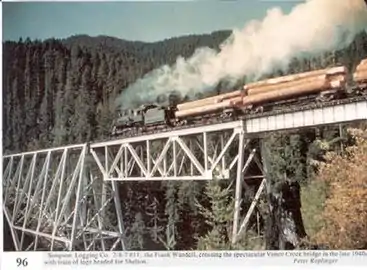Simpson Investment Company
The Simpson Investment Company is a company based in McCleary, Washington in the US Pacific Northwest that specializes in manufacture of forest products. Founded as a logging company in 1890 by Sol Simpson, the company now functions as a holding company for the Simpson Door Company, a manufacturer of wood doors.
Simpson announced in 2008 that it will be entering the "green power" industry by building a new power plant at its Tacoma Tideflats mill that will generate power via the burning of sawmill and other forest waste. In August 2009, construction of the power plant was completed. It generates 55 megawatts of power which is sold to Iberdrola Renovables and used by the Sacramento Municipal Utility District.[1][2] The company is owned by the Reed family. William G. Reed Jr is a chairman on the board.[3]
Divisions
The company was split into two units in 2006. The Green Diamond Resource Company is a spinoff that was created to manage Simpson's forest lands. Both companies are owned by the same shareholders and as with the current subsidiaries, function as separate departments within a large company rather than as completely independent companies.[4] After the split, the three operating subsidiaries of Simpson Investment Company are Simpson Timber Company, Simpson Paper Company, and Simpson Door Company.
Former divisions


The Simpson Lumber Company conducted logging operations and was based in Shelton, Washington. Four mills were sold to Interfor and the Shelton property was sold to Sierra Pacific Industries.[5][6]
The "Simpson Tacoma Kraft Company" produced pulpwood and linerboard products. Previously owned by St. Regis Corporation,[7] the mill was acquired by Simpson in 1985 and sold to RockTenn in 2014.[8][9]
California
Simpson was a prominent forest products company in Northern California for much of the 20th century, after first acquiring California timberland in 1945, eventually managing more than 450,000 acres of forest in California, in what was then known as the Redwood Division and is now mostly part of spinoff Green Diamond Resource Company. Simpson was most prominent in Humboldt County, with Simpson Timber operating lumber mills in Korbel, Brainard, Orick, and Klamath, and Simpson Paper operating pulp and paper mills in Samoa and Eureka. Significant portions of the original 1968 Redwood National and State Parks and its 1977 expansion were former Simpson Timber Company land. Simpson Timber also ran the Arcata and Mad River Railroad for over 30 years.
Railroad
The Simpson Company built and operated a logging railroad known as the Simpson Railroad. When it closed in July 2015 it was the last logging railroad operations in the continental United States,[10] and dates back 120 years. The railroad was once extensive and branched out into several hundred miles of forestland in the Olympic Peninsula but at the end was limited to just ten miles of operational track. The rail line was to transport lumber and as a transportation network to remote logging camps and towns. Construction of the railroad line was an engineering feat as demonstrated by the large and complex bridges built to span gorges and the mountainous terrain the railroad traveled through. The Vance Creek Bridge and the High Steel Bridge were built in 1929 and used until 1985 when the line was abandoned. The Vance Creek Bridge still stands, and the High Steel Bridge is still in use as a forest road. The High Steel Bridge is one of the tallest rail bridges in the United States and has been listed in the National Register of Historic Places.[11]
In January 2019, Green Diamond Resources leased the railroad's remaining 10 miles, plus sidings, to the Peninsular Railway and Lumbermen's Museum, a locally based 501(c)3 non-profit organization. The all-volunteer group is advancing plans to operate several Simpson locomotives and other rolling stock for tourist trains designed to highlight the significant role lumbering and the railroad played in developing the economies of the local area, the Olympic Peninsula, and the entire Pacific Northwest. The name “Simpson Railroad” and associated graphics and logos have been licensed by Simpson for the museum's use. [12]
During the summer months portions of the track are also used for pedal car tours by the Vance Creek Railriders.
References
- John Gillie (2008-04-28). "Simpson Investment Co. will build power plant at Tacoma Tideflats mill". Tacoma News Tribune. Archived from the original on 2008-07-04. Retrieved 2009-08-31.
- "New Tacoma biomass plant starts churning power". Puget Sound Business Journal. 2009-08-11. Retrieved 2009-09-06.
- "Reed family". Forbes. 2015-07-01. Retrieved 14 December 2018.
- Chris Genna (2006-06-25). "Simpson splits units but keeps focus". Puget Sound Business Journal. Retrieved 2009-08-31.
- Interfor purchases four U.S. sawmills
- "Simpson Selling Remaining Lumber Assets to SPI". Archived from the original on 2016-11-06. Retrieved 2016-11-06.
- "3 pulp mills ask compliance extension". Spokane Daily Chronicle. (Washington). Associated Press. November 29, 1972. p. 23.
- "RockTenn to buy Simpson Tacoma for $343 million to establish West Coast mill base, expand in white top". RISI Technology Channels. March 7, 2014. Retrieved December 12, 2018.
- Knauf, Ana Sofia (March 3, 2014). "Georgia company agrees to buy Simpson Tacoma Kraft paper mill". Puget Sound Business Journal. (Seattle, Washington). Retrieved December 12, 2018.
- "Heavy Lifting". Shelton-Mason County Journal. 2007-03-22. Retrieved 2009-09-01.
- "National Register Information System". National Register of Historic Places. National Park Service. January 23, 2007.
- https://www.simpsonrailroad.org Simpson Railroad Website